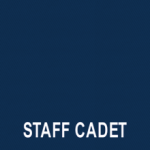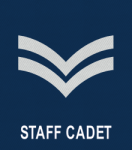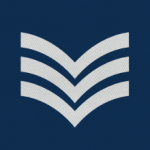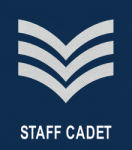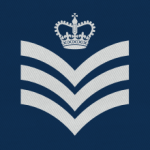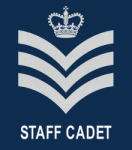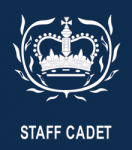Ranks are an integral part of our organisation; they provide a structure that defines how squadrons, wings, regions and the whole corps operates. Below we will explain the cadet ranks. See our staff explanation page (under construction) for more information on staff ranks.
Cadet NCO’s are typically aged between 14 and 20 and have earned their rank through hard work and dedication to the squadron. There is no clear ‘check sheet’ for attaining a rank, however there are some guidelines that will help the Commanding Officer of a squadron make a decision, these exist only for Corporal and Sergeant promotions, and the Commanding Officer may wish to expand on these guidelines to cater for the need of their squadron. Final decision lies with the Commanding Officer over all promotions from Corporal to Flight Sergeant, and decisions will be made based on both individual ability and the structure of the squadron as a whole.
At 1004 Squadron, promotion boards are used as the mechanism to promote cadets up to the rank of Flight Sergeant. The process typically requires eligible cadets who are interested to write an application to the Commanding Officer (CV and Cover Letter), if successful a date and time is provided for their board where they are typically assessed in various areas such as leadership before sitting on an interview.
Positioning
Rank slides can be found attached to shoulders of No.2 (Blue) uniform and centrally on the Chest of No.3 (Green) uniform. Rank slides should be at the bottom of the epaulette with the chevrons pointing down for those looking at the rank slide. Cadet rank slides should always be dark blue with silver weaving for the chevrons, other colours (including green or pattern fabric) for the backing are not permitted, even when doing fieldcraft.
Squadron Structures
The guidelines for a squadrons structure are found in PI101. However these are not rigid and can be altered based on current strengths of NCO’s and the needs of the squadron. One example is that Staff Cadets (Over 18 year olds) are not held against the structure, as they may not be able to attend regularly with work/university commitments.
For a small squadron (30-45 cadets), a typical structure is as follows: 1 CWO; 1FS; 4Sgt; 4Cpl.
Staff Cadet – Cdt
Staff Cadet, written on the bottom edge of the rank slide (may also contain rank indicators in the blue space- see CWO for example), shows that the cadet is over 18, and therefore has legal responsibilities of child protection above that of a cadet. The cadet bears no authority above that of an under 18 counterpart of the same rank in the eyes of the ATC under normal operation. However, they do hold some extra responsibilities because of British law when it comes to child protection issues, whatever their rank.
Requirements:
– Over 18
– Completed the AVIP Course (Adult Volunteer Induction Package Course)
– Signed the Staff Cadet Agreement
– Hold an Enhanced Certificate from DBS (Disclosure and Barring Service)
– Must be approved by the Commanding Officer to stay on past 18 (Must hold qualifications or experiences useful to the unit and Corps)
Cadet Corporal – Cdt Cpl
Corporal is the lowest rank in the NCO structure of the ATC, however it is worth noting that it is still higher than CCF Junior Corporals or ACF Lance Corporals. Corporals are normally expected to keep discipline and order amongst the cadets. The rank of Corporal is the only ‘Junior NCO’ rank in the ATC, and thus, despite having authority and responsibility are still mostly in a developmental phase of their cadet career.
Guidelines:
– 15 Years Old
– 2 years as cadet
– Leading Classification
– Completed Basic Drill Course (or similar)
– Completed (and passed) JNCO Course
– Regular Attendance (~90%) in uniform (~85%)
Preferable, but not Guideline:
– Senior Classification
– Attended at least 1 camp
– Completed Corps Drill Course
– At least 1 skills badge (i.e. First Aid, Marksman, Band, Comms, Nijmegen)
– Regular attendance of weekend and wing events.
Equivalent Cadet Force Ranks:
– ACF | Corporal
– SCC | Leading Rate
Cadet Sergeant – Cdt Sgt
The first ‘Senior NCO’ rank is expected to be able to carry out all responsibilities of a Corporal, but is also expected to be able to manage and support the Corporals beneath them. As the lowest ‘Senior NCO’ rank, it is expected that Sergeants are still developing and will continue to gain experience and grow in ability.
Guidelines:
– All Corporal guidelines complete
– 16 Years Old
– 1 year as Corporal
– Senior Classification
– Completed Corps Drill Course (or similar)
– Completed (and passed) SNCO Course
– Regular Attendance (~90%) in uniform (~85%)
Preferable, but not Guideline:
– Master Classification
– Attended at least 1 Wing/Squadron camp
– Attended at least 1 Corps camp (i.e. RIAT)
– Completed Advanced Drill Course
– At least 2 skill badges (i.e. First Aid, Marksman, Band, Comms, Nijmegen)
– Regular attendance of weekend and wing events.
Equivalent Cadet Force Ranks:
– ACF | Sergeant
– SCC | Petty Officer
Cadet Flight Sergeant – Cdt FS
At the rank of Flight Sergeant, a cadet is expected to have demonstrated consistent competency at the rank of Sergeant and is normally considered to be almost complete in their NCO development at the rank of Flight Sergeant. Flight Sergeants will take a more ‘supervisory’ role by ensuring that all is well within the cadet ranks. As they may regularly be one of the highest ranks at their squadron or at events, they will be expected to be able to act as a role model to all cadets and NCO’s. Guidelines are not used at this rank, as Sergeants are expected to be well-rounded, and so Flight Sergeants may seek further development in some specialist areas. Rough guidelines can, however, be made based on previous guidelines.
Guideline:
– All Sergeant guidelines complete
– 17 Years Old
– 1 year as Sergeant
– Master Classification
– Completed Advanced Drill Course (or similar)
– Regular Attendance (~85%) in uniform (~80%)
Preferable, but not Guideline:
– Attended at least 3 camps (at least 1 Squadron/Wing and 1 Corps)
– Show a high degree of skill in a ‘specialist subject’
Equivalent Cadet Force Ranks:
– ACF | Staff Sergeant
– SCC | N/A
Cadet Warrant Officers – CWO
Cadet Warrant Officers are expected to be a more matured version of a Flight Sergeant, and to be a reliable link between the staff and cadets. This could almost be viewed as a ‘transition phase’ between being a cadet and becoming staff. The naming of the rank is often a source of confusion, however the correct reference to this rank is “Warrant Officer”, dropping the “cadet” prefix as is done with all other cadet NCO ranks.
This is the only cadet rank with strict requirements (See below) and cannot be promoted by the Commanding Officer, only recommended, as it is the decision of the Wing’s Commanding Officer to promote.
Requirements:
– 18 years old or over
– Attend an interview with Wing staff members to determine if the cadet should be promoted
Guideline:
– All Sergeant guidelines complete
– 1 year as a Flight Sergeant
– Instructor cadet qualified
Preferable, but not Guideline:
– Completed Advanced Drill Course (or similar)
– Regular attendance at squadron (70%-90% depending on circumstances)
– Attended at least 3 camps (at least 1 Squadron/Wing and 1 Corps)
– Show a high degree of skill in a ‘specialist subject’
Equivalent Cadet Force Ranks:
– ACF | Sergeant Major (Regiment is equal to ATC rank, Company slightly subordinate)
– SCC | N/A
